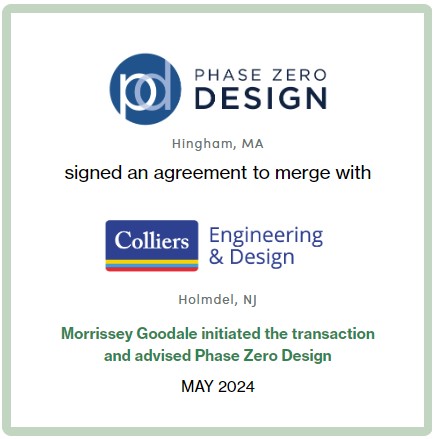Word on the street > Trinity Consultants—Advancing Industry M&A Best Practices; 7 Reasons Why Strategic Plans Work—and 7 Reasons They Fail
Word on the Street: Issue 198
Weekly real-time market and industry intelligence from Morrissey Goodale firm leaders.

Trinity Consultants—Advancing Industry M&A Best Practices
We’re delighted to announce that the recipient of this year’s M&A Best Practices Award is Trinity Consultants (Dallas, TX).
1. Overview: Founded in 1974, Trinity Consultants is a leading global environmental consulting firm that provides services and solutions in the EHS regulatory compliance, built environment, life sciences, and water and ecology markets. The company employs over 2,000 professionals specializing in highly technical, compliance-driven services that address clients’ mission-critical needs. Trinity is headquartered in Dallas, Texas, and operates from 100 offices worldwide with a national footprint in the United States and a presence in key international markets across North America, Europe, Asia, and Australia. The firm is backed by Oak Hill Capital (New York, NY), an industry-focused, theme-based private equity firm working in the North American middle market.
2. M&A credentials: Trinity has completed over 35 acquisitions since 2008, so the firm’s leadership and management team knows a thing or two about how to make and—importantly—integrate acquisitions.
3. Best practice described: Indeed, the best practice that Trinity management chose to highlight in their application pertained to integration. They take great care every step of the way—from planning to execution to reflection/review/lessons learned—to ensure the successful integration of each acquisition. Their best practice focused on post-closing communications. With any acquisition, Trinity’s goals are to ensure a smooth transition of billable resources. They do this using change management—referencing the ADKAR methodology—and communications best practices to minimize any attrition. The firm’s post-close change management and communication process includes the following four elements:
- Employee and client FAQs
- Personalized key client notifications
- Employee welcome meetings
- Speedy migration to Trinity collaboration tools
These four elements are customized for the specifics of each acquisition and involve a series of collaborative initiatives that taken together have resulted in Trinity consistently achieving (or exceeding) its integration goals. Paul Greywall, president and CEO of Trinity, commented, “It is an honor to be recognized by Morrissey Goodale as implementing an M&A best practice. Trinity has made many acquisitions over the past 16 years, and we strive to have a positive experience for the customers and employees of our acquired businesses. Consulting businesses are people-centric, and we closely collaborate with our acquired businesses on our integration journey.”
4. Award presentation: The M&A Best Practices Award will be presented next week at the 10th annual Western States M&A and Business Symposium in Las Vegas. Accepting the award for Trinity will be Greywall. In addition to receiving the award, Trinity has elected to direct the $1,000 charitable donation that accompanies it to the American Red Cross.
5. Simply the best: Our leadership team carefully reviewed all 75 applications for this year’s award. The scope and depth of the best practices were so comprehensive, and such was the thoughtfulness and care with which they were presented, that we agreed that it would be best to recognize not only the award recipient, but also a select group of those acquirers whose best practices deserved acknowledgement. When engaging with these firms, potential sellers can have a high degree of confidence that they are dealing with serious, skilled, competent acquirers that know how to craft win-win transactions and integrate them successfully. And those firms are:
- Atwell, LLC (Southfield, MI) (ENR #71): For best practices in Integration Execution.
- Pape Dawson (San Antonio, TX) (ENR #93): For Integration Planning.
- STV Inc. (New York, NY) (ENR #35): For Acquisition Candidate Courtship/Management.
- RTM Engineering (Schaumburg, IL) (ENR #313): For Acquisition Candidate Courtship/Management.
- Woolpert (Dayton, OH) (ENR #47): For Acquisition Candidate Courtship/Management.
6. Behind the Excellence in Acquisitive Growth Awards Series: The M&A Best Practices Award is the second of three annual awards in our Excellence in Acquisitive Growth Awards Series designed to recognize the most accomplished acquirers in the AE and environmental industry and create a forum to share best practices and achieve better outcomes. Past award recipients include Bowman Consulting Group (ENR #78), IMEG (ENR #52), TRC Companies (ENR #16), Salas O’Brien (ENR #39), Terracon (ENR #20), and Englobe.
7. Next up? Best Post-Transaction Performance Award: The third award in our Excellence in Acquisitive Growth Series is the Best Post-Transaction Performance Award. We will be opening the application for this award later this month. The award will be presented at our Texas and the South M&A and Business Symposium at the five-star Post Oak Hotel at Uptown Houston in October.
Questions? Comments? Suggestions? You can reach Mick Morrissey @ 508.380.1868 or [email protected].
7 Reasons Why Strategic Plans Work—and 7 Reasons They Fail
Every AE firm I work with these days is feeling the pressure of unprecedented challenges and opportunities. Whether it’s the astonishing acceleration of technological advancements, the ever-increasing list of client demands, the growing sophistication of the competition, or the increasingly complex regulatory environment, AE firms must be more strategic than ever to remain competitive. Without a holistic strategic plan, even the strongest firms risk falling behind, losing market share, and ultimately failing to meet their business objectives.
In this high-stakes environment, effective strategic planning is not just a best practice—it’s a necessity. It provides a roadmap for navigating the complexities of the market, ensuring that firms can capitalize on new technologies, meet evolving client demands, and comply with stringent regulations. Understanding the reasons why strategic plans succeed or fail is crucial for any AE firm looking to thrive in this dynamic landscape.
From my seat, here are seven reasons why strategic plans succeed and seven reasons they fail.
The plans that SUCCEED…
1. Have clear vision statements and goals. Successful strategic plans are anchored in clear visions and specific, measurable goals. Well-defined visions provide direction and purpose, while concrete goals offer targets to aim for. This clarity ensures that everyone in the firm understands its objectives and can align their efforts accordingly. Now, I get that financial performance is a result of balancing the learning and growth of employees with process improvements and market positioning, etc., but firms that aren’t afraid to get specific about revenue and profit targets—well, they tend to achieve more revenue growth and profitability. From what I can tell, it’s no coincidence.
2. Include comprehensive market analysis. Effective strategic planning involves thorough market analysis. Firms that understand industry trends, competitor activities, and customer needs accurately identify opportunities and threats. This knowledge allows them to position themselves advantageously in the market, tailor their services to client demands, and stay ahead of competitors. If you are serious about expansion of markets, services, and/or geographies, you have to bring the outside world in to make grounded assessments and sound decisions.
3. Invite all employees to participate at some level. Engaging as many people in the firm as possible in the planning process (e.g., all-employee survey, etc.) fosters a sense of ownership and commitment. While their insights and feedback enhance the plan’s relevance and feasibility, it’s even more important that they support and contribute to the plan’s success. If there is such a thing as a reasonable person, they don’t need to get everything on their wish list to buy in, but they do need to be listened to.
4. Are flexible and adaptable. The ability to adapt to changing circumstances is a hallmark of a successful strategic plan. AE firms operate in dynamic environments where disruption has become the norm. Flexible plans that allow for adjustments enable firms to respond to new challenges and opportunities without deviating from their long-term goals. The world happens—that’s a nice way of saying “you-know-what happens”—and when it does, you better not be wearing lead shoes.
5. Efficiently allocate resources. Allocating resources efficiently is critical for the execution of strategic plans. You need the requisite financial resources, human capital, and technological tools. Successful firms ensure that they have the necessary resources to implement their strategies effectively, which often involves prioritizing initiatives and making tough decisions about where to invest. They pay attention to the law of diminishing returns—set out to do three things, you’ll get them all done; set out to do five things, you’ll get one of them done; set out to do ten things, you’ll get none of them done.
6. Include the monitoring and evaluation of performance. Regular monitoring and evaluation of progress are essential for strategic plans to succeed. Firms that set up key performance indicators (KPIs) and conduct periodic reviews track their progress and make necessary adjustments. This continuous feedback loop helps them identify what is working and what needs improvement, and it keeps the plan from becoming a “check-the-box” activity.
7. Have leadership’s full commitment. Strong leadership is fundamental to the success of strategic plans. Leaders who are committed to the plan and working on the firm, not just in it, inspire and motivate their teams. They play a crucial role in communicating the vision, setting the tone, and driving the implementation. Their dedication ensures that the strategic plan remains a priority.
The plans that FAIL…
1. Are overly ambitious or unrealistic. Strategic plans fail when firms set goals that are overly ambitious or unrealistic. While aiming high is important, goals must be achievable and grounded in reality. I’m all for stretch goals, but when the cognitive dissonance is simply too much, frustration, diminished morale, and a sense of failure results when targets are not met.
2. Ignore internal weaknesses. Some executives refuse to look in the mirror for an honest assessment of their firms’ internal weaknesses. Whether it’s fragile egos, fear, or hubris, they don’t want to accept that every aspect of their firm isn’t simply spectacular. But ignoring issues such as skill gaps, inefficient processes, or cultural misalignments undermines the execution of the plan. An honest assessment of internal capabilities is crucial for realistic and effective planning.
3. Botch communication. Poor communication is a significant barrier to the success of a strategic plan. When the plan is not effectively communicated to all members of the organization, misunderstandings and misalignments occur. Clear, consistent, and timely communication is necessary to ensure everyone is on the same page. Communication is not a nice-to-have—it’s a must-have.
4. Avoid change. Change in our industry is often met with resistance, particularly in established firms with ingrained practices and cultures. Strategic plans that require moderate to significant change routinely fail when there is not enough buy-in from the team. Overcoming resistance through change management strategies (including being clear about what is NOT changing), training, and support is essential.
5. Misinterpret risk. Failing to anticipate and manage risk often leads to the downfall of strategic plans. Risks can come from various sources, including economic downturns, regulatory changes, or technological disruptions. Firms that have been blindsided by unforeseen events often lack a reasonably robust risk management framework that takes into account how likely and impactful these risks are.
6. Underestimate execution challenges. Crafting a strategic plan only gets you to the starting line; then you need to get your hands in the dough. Underestimating the complexities and obstacles involved in execution leads to front-end loading the plan with unrealistic amounts of work. Remember, you have day jobs.
7. Misalign incentives. Misaligning incentives with strategic goals is a surefire way to torpedo a strategic plan. For instance, if employees are rewarded for short-term results rather than long-term strategic achievements, they may not prioritize the strategic plan. Aligning incentives with strategic objectives is crucial for ensuring everyone works toward the same goals.
For help developing your firm’s strategic plan, call/text Mark Goodale at 508.254.3914 or email [email protected].
Market Snapshot: U.S. Regions
In recent years, we’ve seen tremendous growth happening in Southwestern and Southeastern states such as Texas, Arizona, Florida, Georgia, Tennessee, and the Carolinas. Another region that has been popping up in our research projects with impressive growth is the Rocky Mountain. Despite the significant population decrease in recent years, the Far West region still represents over 20% of the U.S. economy and had above-average GDP growth rates since 2019 (and a record number of attendees is expected at the 10th Western States M&A and Business Symposium in Las Vegas next week). The Midwest has averaged the highest ABI (AIA/Deltek’s Architecture Billings Index) over the past 18 months, although it took a hit in March.
There are opportunities for growth all over the country as current and future sentiment remains largely positive for the AE industry. You may be asking, but what about the Northeast? We took a closer look at some of the indicators available by region in the Q2 2024 ACEC Engineering Business Sentiment Report and found that firms in the Northeast region are the most optimistic. Here are the highlights regarding the Northeast region (New York, New Jersey, Pennsylvania, Connecticut, Rhode Island, Vermont, New Hampshire, Massachusetts, and Maine):
- The Northeast had the highest (and best) rating as well as year-over-year increase for current economic conditions.
- The best outlook for firm finances 12 months from now comes from firms in the Northeast.
- The highest rating and year-over-year increase in future backlog sentiment was from Northeast-based firms.
- According to the survey, Northeast firms have the most positive sentiment about future hiring.
- Firms in the Northeast region have the lowest percentage of leaders who anticipate a recession in the next six months.
For more regional insights, check out the 2024 AE Market Intelligence Webinar. Click here to access recording and materials.
To learn more about market intelligence data and research services offered by Morrissey Goodale, schedule an intro call with Rafael Barbosa.
Weekly M&A Round Up

Congratulations to Phase Zero Design (Hingham, MA): The commercial architecture, interior design, and branding firm signed an agreement to merge with Colliers Engineering & Design (Holmdel, NJ) (ENR #50), a national multi-discipline engineering, architecture, design, and consulting firm. The partnership will enable Colliers to strengthen architecture service offerings nationwide and provide new services in existing markets. We’re thankful that the Phase Zero team trusted us to initiate and advise them on this transaction.
U.S. M&A down 5%: Last week we reported domestic deals in Massachusetts, Georgia, Florida, and Connecticut. International deals were announced in Norway, Spain, Canada, and Ireland. You can check all of last week’s M&A news here.
October 16-18, 2024 Houston, TX
Texas and the South M&A and Business Symposium
Over two-plus information-packed days, come together to discuss strategy, innovation, and M&A trends while networking with AE industry executives.
Learn More
AI & Innovation
Tap Into the Power of AI for your Firm
We’re partnering with the AI experts at Thrivence to bring AI Education and Business Solutions to the AE and environmental consulting Industry. Introducing a powerful 90-minute, on-demand AI Masterclass designed and delivered by CEOs for CEOs.

Searching for an external Board member?
Our Board of Directors candidate database has over one hundred current and former CEOs, executives, business strategists, and experts from both inside and outside the AE and Environmental Consulting industry who are interested in serving on Boards. Contact Tim Pettepit via email or call him directly at (617) 982-3829 for pricing and access to the database.
Are you interested in serving on an AE firm Board of Directors?
We have numerous clients that are seeking qualified industry executives to serve on their boards. If you’re interested, please upload your resume here.
Subscribe to our Newsletters
Stay up-to-date in real-time.











